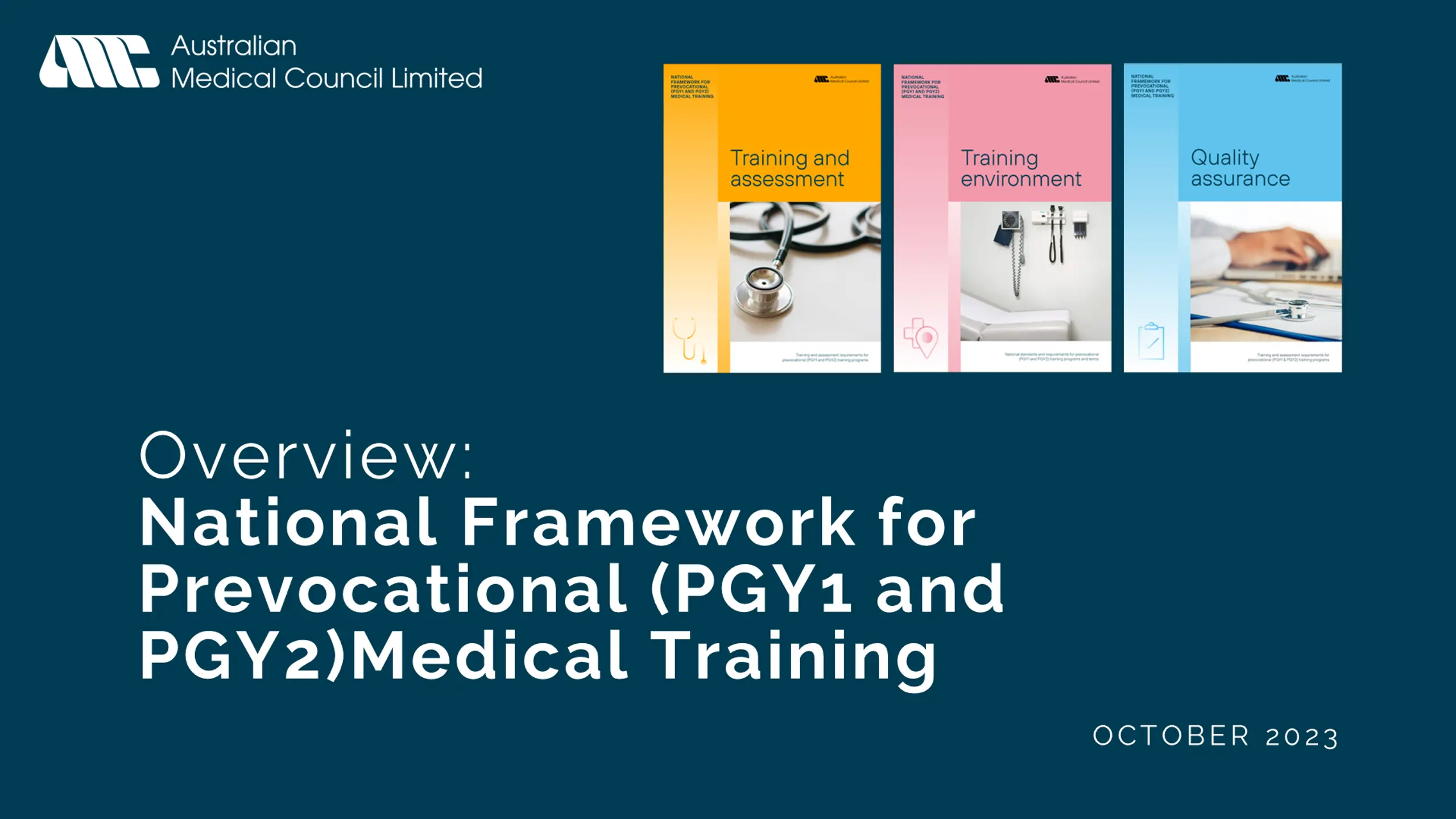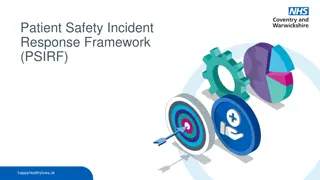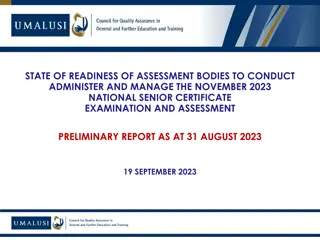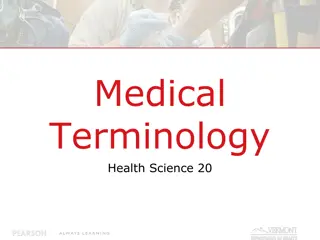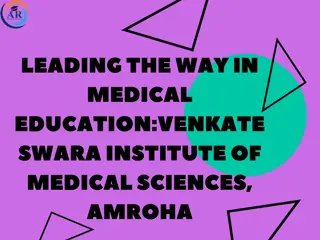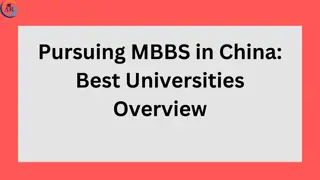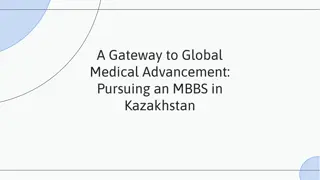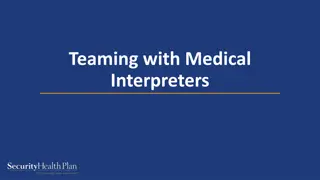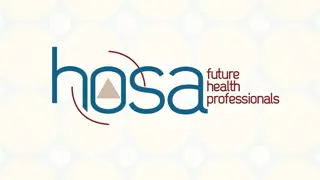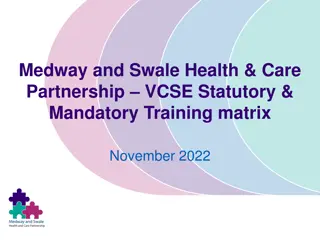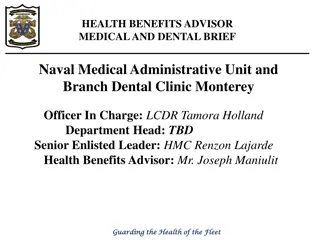National Framework for Prevocational Medical Training Overview 2023
Review & development work, stakeholder engagement, 2-year framework establishment by AMC, PGY1 & PGY2 roll-out timelines, training requirements, revised framework details. Aims to enhance training quality & consistency for better healthcare outcomes.
Download Presentation

Please find below an Image/Link to download the presentation.
The content on the website is provided AS IS for your information and personal use only. It may not be sold, licensed, or shared on other websites without obtaining consent from the author.If you encounter any issues during the download, it is possible that the publisher has removed the file from their server.
You are allowed to download the files provided on this website for personal or commercial use, subject to the condition that they are used lawfully. All files are the property of their respective owners.
The content on the website is provided AS IS for your information and personal use only. It may not be sold, licensed, or shared on other websites without obtaining consent from the author.
E N D
Presentation Transcript
Overview: National Framework for Prevocational (PGY1 and PGY2)Medical Training OCTOBER 2023
Timelines Review and development work including extensive stakeholder consultation: 4 formal consultation periods Stakeholder workshops and Reference Group meetings Speaking engagements at conferences and stakeholder meetings All Health Ministers' agreed to recommendations of 2015 COAG report including: Two-year capability and performance framework Entrustable professional activities E-portfolio specifications The AMC was tasked to develop the 2-year framework by AHMAC (now HCEF) The AMC commenced a review of the PGY1 Framework 2020 2018 2019 2020-22
Timelines PGY2 may be implemented in either 2024 or 2025. may be implemented across a jurisdiction at the same time or PMCs and health services may decide that some health services will implement PGY2 in 2024 and others in 2025. Preparation for implementation AMC developing resources and communication to support implementation PGY1 PGY1 components implemented in 2024 AMC published the new 2-year National Framework 2024 2022 2023 2025
Overview of the National Framework https://www.amc.org.au/framework Training and assessment requirements for prevocational training programs National standards and requirements for prevocational training programs and terms AMC domains and procedures for assessing and accrediting prevocational training accreditation authorities
Revised two-year prevocational framework Framework PGY1 Framework PGY2 Medical Board General registration Certificate of completion of PGY2 Point of General Registration remains at satisfactory completion of PGY1 Expansion to PGY2 intended to provide better support and structure, while maintaining generalist experiences new certificate of satisfactory completion of PGY2 (AMC?). PGY1 and PGY2 (in prevocational framework leading to certificate) are exempt from the Medical Board of Australia's new CPD requirements Entry into specialty training in PGY2 permitted where specialist colleges allow.
Key aims STRENGTHEN ABORIGINAL AND/OR TORRES STRAIT ISLANDER HEALTH INCREASE FOCUS ON CLINICAL WORK ALIGN WITH COMMUNITY HEALTH NEEDS IMPROVE SUPERVISION AND FEEDBACK PROVIDE BROAD GENERALIST EXPERIENCES INCREASE EMPHASIS ON WELLBEING IMPROVE NATIONAL CONSISTENCY LONGITUDINAL APPROACH
Overview: Training and assessment
Training and Assessment Supported by: e-portfolio Major changes Revised outcome statements to better reflect community health needs, incl new Aboriginal and/or Torres Strait Islander outcomes Inclusion of EPAs focus on clinical work, more feedback based on observed practice Terms and EPAs mapped to outcome statements - progress against outcomes recorded in e-portfolio - more data for end of term and end of year assessments Global judgment at the end of the year by a panel rather than an individual
What is an EPA? Entrustable Professional Activity (EPA) An EPA is a description of work undertaken regularly in day-to-day clinical practice. Performance of an EPA can be assessed. In the assessment a supervisor makes a judgement about how safely the prevocational doctor can perform this piece of work the level of entrustability. EPAs Describe the work doctors do
What are the four EPAs? Conduct a clinical assessment of a patient incorporating history, examination, and formulation of a differential diagnosis and a management plan. EPA1 Clinical assessment Recognise, assess, escalate appropriately, and provide immediate management to deteriorating and acutely unwell patients. (This includes acute deterioration in mental health) Recognition and care of the acutely unwell patient EPA2 Appropriately prescribe therapies (drugs, fluids, blood products, inhalational therapies including oxygen) tailored to patients needs and conditions, either in response to a request by the treating team or self-initiated. EPA3 Prescribing Team communication - documentation, handover and referrals Communicate about patient care, including accurate documentation and written and verbal information to facilitate high quality care at transition points and referral. EPA4 https://www.amc.org.au/framework
Assessment of EPAs Format: Activity-based discussion - as part of routine clinical work. An EPA assessment is not "pass/fail" - the supervisor makes a judgement about how safely the prevocational doctor can perform this work, the level of entrustability. Number of EPA assessments: Global requirements 10 minimum across the year 2 or 3 within each term Specific requirements EPA 1: 4 minimum across the year EPA 2, 3 & 4: 2 minimum across the year Assessors: At least 1 EPA a term must be assessed by a specialist or equivalent (term supervisor). Other EPAs in each term can be assessed by other health professionals once training in EPA assessments has been completed: e.g. specialists, registrars, nurse/ nurse practitioners, pharmacists, others as appropriate
Certifying completion Global judgement by an assessment panel at the end of each year. No requirement to pass a specified number of assessments or terms. Satisfactory performance = attainment of the required standard (prevocational outcomes) by end of year Process supported by: PGY1 Health service submits certificate of completion to the Medical Board of Australia Including: record of learning record of assessments record of terms completed e-portfolio PGY2 Health service submits certificate of completion to AMC (TBC)* Evidence provided to the assessment panel to support decision making: Program length (47 weeks) Term requirements (revised parameters) Achievement of prevocational outcomes: Term assessments (mid and end) Assessment of EPAs optional in 2024 Other learning activities (documented in e-portfolio)
Overview: Training environment
Training Environment Used by postgraduate medical councils in accrediting training programs Used by training providers in delivering prevocational training
National Standards These standards are used by postgraduate medical councils in accrediting training providers. Major changes Expanded to PGY2 Inclusion of new term requirements / assessment requirements (EPAs, Assessment Review Panel etc.) Strengthened Aboriginal and Torres Strait Islander standards Strengthened wellbeing standards Mandated term supervisor training (within 3 years) Mandated use of national standards In future - Mandatory community terms
Requirements for programs and terms Program level requirements Term descriptions PGY1 PGY2 Term descriptions must include: the role of the prevocational doctor the team clinical experiences (1 or 2) learning (prevocational) outcomes supervisors assessment Length Minimum 47 weeks Minimum 47 weeks Structure Minimum of 4 terms (of at least 10 weeks) Minimum of 3 terms (of at least 10 weeks) Specialties Maximum 50% any specialty and 25% subspecialty At least 50% of the year Maximum 25% subspecialty in a year At least 50% of the year Embedded in clinical teams Service terms - relief and nights Maximum 20% of the year Maximum 25% of the year Program content - Clinical experiences Focus on: A. Undifferentiated illness A. Undifferentiated illness program rather than terms B. Chronic illness B. Chronic illness breadth of experience C. Acute and critical illness C. Acute and critical illness D. Peri-operative/ procedural
Example PGY1 programs Clinical experience categories D. Peri-operative/ procedural A. Undifferentiated illness C. Acute and critical illness B. Chronic illness Term 1 Geriatric medicine Term 2 General Practice (rural) Term 3 Renal Medicine Term 4 Acute surgical unit Example 1 C B C A B D C B Term 1 Medical Assessment unit A C Term 3 Emergency Department Term 2 General Medicine Term 5 Term 4 Relief Example 2 Interventional Cardiology B C A D Term 2 General surgery Term 3 Emergency Department Term 4 Acute surgical unit Term 1 Example 3 Endocrinology A C B C D C D
Example PGY2 programs Clinical experience categories A. Undifferentiated illness C. Acute and critical illness B. Chronic illness Term 1 Acute Psychiatric unit Term 3 Term 2 Emergency Department (metro) Integrated General Practice/ Emergency (rural) Example 1 B A B C C A Term 2 Term 3 Term 4 Paediatrics Term 1 Example 2 Intensive care unit Rehabilitation General Practice B C A A C B Term 4 Vascular surgical unit Term 2 Emergency Department Term 1 Term 3 General surgery Term 5 Relief Example 3 Intensive care unit C A B C B C C
Overview: Quality Assurance
Quality Assurance Used by AMC to accredit postgraduate medical councils
Domains and procedures for assessing and accrediting prevocational training accreditation authorities Overview of domains for assessing PMCs Domain 1 Purpose and Governance Changes No major changes Included requirement to use and respond to external sources of data (e.g. the Medical Training Survey) Domain 2 Independence Operational management Domain 3 Processes for accreditation of prevocational training programs Domain 4 Stakeholder collaboration Domain 5 Procedures for accrediting PMCs
Overview: National e-portfolio
e-portfolio In 2023 the AMC was advised that all jurisdictions had agreed to a national approach and to commence work on the procurement and development of a national e-portfolio. HECF have established National e-Portfolio Project Board (NEPB) with PMCs and Health Departments represented Procurement process occuring mid- to late-2023. Framework supported by: Including: record of learning tracking against outcomes platform for assessments record of assessments reflections ability to upload learning activities program delivery/ administration - reminders / record of terms completed data collection (e.g. accreditation) e-portfolio
Overview: Preparing for implementation
Resources to support implementation www.amc.org.au/framework FREQUENTLY ASKED QUESTIONS WRITTEN GUIDE FOR PGY1 & PGY2 DOCTORS + SUMMARY FLYER EXAMPLE PGY1 AND PGY2 PROGRAMS WRITTEN GUIDE FOR SUPERVISORS + SUMMARY FLYER TEMPLATES: BEGINNING OF TERM DISCUSSION TERM DESCRIPTION GUIDANCE RESOURCE: ABORIGINAL AND/OR TORRES STRAIT ISLANDER HEALTH AND CULTURAL SAFETY CONTENT* WRITTEN GUIDE FOR ASSESSMENT REVIEW PANELS VIDEO RESOURCES *to be published
Resources to support implementation Written Guide for Supervisors + Summary Flyer Written Guide for Assessment Review Panels Written Guide for PGY1 & PGY2 Doctors + Summary Flyer
Resources to support implementation Term description template PMCs currently updating term descriptions for existing terms including clinical experience categories. Example PGY1 & PGY2 programs Provides examples of programs and flexibility within National Framework
Resources to support implementation Video: Introduction to the Framework To be utilised in supervisor training Used by prevocational doctors and medical students to familiarise themselves with the Framework.
Resources to support implementation Video: Introduction to the EPAs To be utilised in supervisor training Used by prevocational doctors and medical students to familiarise themselves with the assessment format.
Resources to support implementation Video: Assessment in 2024 Short snippet to clarify assessment requirements for 2024 (prior to implementation of an e-portfolio)
